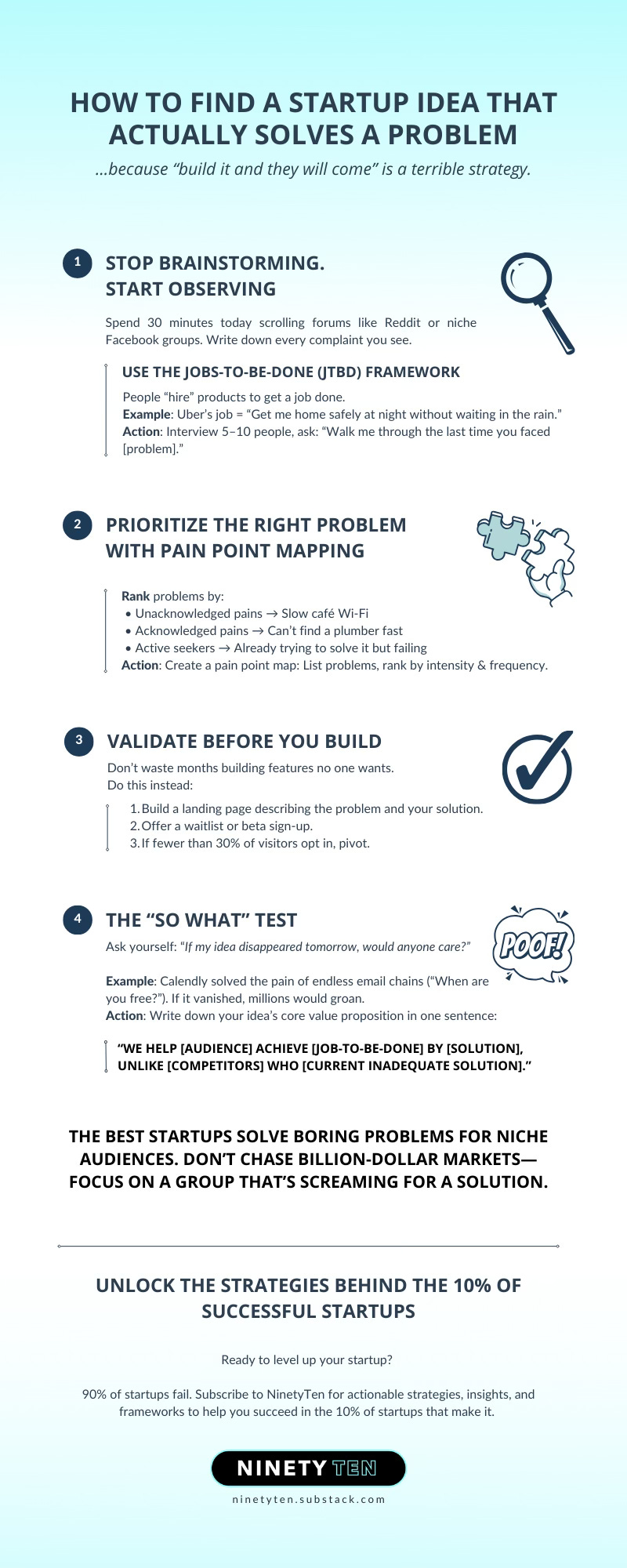How to Find a Startup Idea That Actually Solves a Problem
…because “build it and they will come” is a terrible strategy.
You’re sitting in a café, staring at your latte, wondering why your last “brilliant” startup idea fizzled. Here’s the truth: Ideas don’t fail because you’re not smart enough. They fail because they don’t solve a real problem for a specific group of people. Let’s fix that.
Step 1: Stop Brainstorming. Start Observing.
Forget whiteboards and sticky notes. The best ideas come from watching people struggle. Grab your notebook and go where your target audience hangs out—a coworking space, a parent’s Facebook group, a subreddit. Look for phrases like “I hate how…” or “Why does this always happen?”
Example: Brian Chesky and Joe Gebbia didn’t invent Airbnb because they loved travel. They noticed a problem: people couldn’t afford San Francisco rent, and conference attendees couldn’t find hotels. They rented out air mattresses in their apartment.
Action: Spend 30 minutes today scrolling forums like Reddit or niche Facebook groups. Write down every complaint you see.
The Jobs-to-be-Done Framework (JTBD): What’s the “Job” Your Customer Hires a Product to Do?
People don’t buy products—they “hire” them to get a job done. A “job” could be physical (find a ride home), emotional (feel confident in meetings), or social (impress a date).
Example: Uber’s job isn’t “provide rides.” It’s “get me home safely after midnight without waiting in the rain.”
Here’s how to use JTBD:
Interview 5–10 people in your target audience. Ask: “Walk me through the last time you faced [problem].”
Listen for emotional triggers (“I was so frustrated…”) and workarounds (“I ended up using Excel, but it took hours”).
Identify the core job they’re trying to accomplish.
Step 2: Prioritize the Right Problem With Pain Point Mapping.
Not all pain points are equal. Use this hierarchy:
Unacknowledged Pains: Problems people tolerate but don’t vocalize (e.g., slow Wi-Fi at cafés).
Acknowledged Pains: Complaints they’re aware of (e.g., “I can’t find a plumber fast enough”).
Active Seekers: People already trying (and failing) to solve the problem.
Example: Slack didn’t invent workplace chat. They solved the pain of email overload and lost files by centralizing communication.
Action: Create a pain point map:
List every frustration you’ve observed.
Rank them by intensity (how much does this hurt?) and frequency (how often does it happen?).
Focus on pains that are frequent, intense, and poorly addressed.
Step 3: Validate Before You Build.
Founders waste months building features no one wants. Instead, test your idea with a “minimum viable solution.”
Example: Dropbox’s MVP was a 3-minute video explaining how their product would work. It drove 75,000 sign-ups overnight.
Here’s what to do next:
Build a landing page describing the problem and your solution.
Offer a waitlist or beta sign-up.
If fewer than 30% of visitors opt in, pivot.
Step 4: The “So What?” Test.
Ask yourself: If my idea disappeared tomorrow, would anyone care? If the answer isn’t “hell yes,” dig deeper.
Example: Calendly solved the pain of endless email chains (“When are you free?”). If it vanished, millions would groan.
Action: Write down your idea’s core value proposition in one sentence:
“We help [audience] achieve [job-to-be-done] by [solution], unlike [competitors] who [current inadequate solution].”
Steal This Template
Grab a notebook and answer these questions:
Problem: What specific, recurring issue did you observe? (e.g., “Freelancers waste 4 hours/week chasing invoices”)
Audience: Who feels this pain most acutely? (e.g., “Freelance graphic designers with 10+ clients”)
JTBD: What job are they hiring a solution to do? (e.g., “Get paid faster without awkward follow-ups”)
Existing Workarounds: How are they solving it now? (e.g., “Sending PayPal reminders manually”)
Your Solution: What’s your 10x better version? (e.g., “Auto-send invoices with polite nudges via SMS”)
Final Advice: Start Small, Stay Ruthless
The best startups solve boring problems for niche audiences. Don’t chase billion-dollar markets—focus on a group that’s screaming for a solution.
Want to stay ahead of the 90%?
NinetyTen is a weekly newsletter packed with battle-tested strategies, frameworks, and insights to help you go from early traction to product-market fit—faster and with fewer mistakes.
📩 Subscribe now and start building like the 10%.





